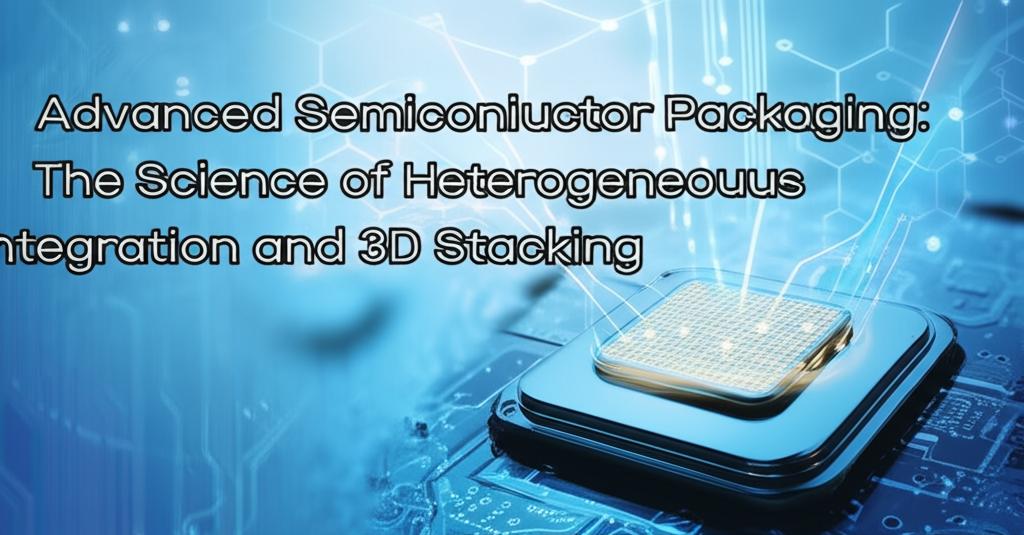The physical limits of traditional transistor scaling, often described by Moore's Law, are pushing the semiconductor industry towards innovative packaging solutions. Advanced packaging has evolved from merely protecting the chip and connecting it to the outside world into a critical performance enabler. Two key pillars of this revolution are heterogeneous integration and 3D stacking, driving significant leaps in processing power, energy efficiency, and miniaturization.
Understanding Heterogeneous IntegrationHeterogeneous Integration (HI) refers to the assembly of multiple, separately manufactured semiconductor components, known as "chiplets," onto a single package substrate or interposer. These chiplets can originate from different process nodes, be made of different materials (like silicon, III-V compounds), or perform vastly different functions (CPU, GPU, memory, I/O, RF).
Instead of building a large, monolithic System-on-Chip (SoC) where all functions reside on one piece of silicon—which can be complex and suffer from lower manufacturing yields for larger sizes—HI allows for a modular approach. High-performance logic might be fabricated on the latest, most expensive process node, while analog or I/O functions could use older, more cost-effective nodes. These optimized chiplets are then interconnected within the package using sophisticated techniques.
Key enabling technologies for HI include:
- Interposers: Intermediate substrates (often silicon, organic materials, or emerging glass) with high-density wiring to connect chiplets to each other and to the main package substrate.
- Fan-Out Packaging (FOWLP/FOPLP): Techniques where connections are fanned out from the chip's surface, allowing for more I/O connections and direct chiplet-to-chiplet linking without a traditional substrate directly underneath.
- Bridge Technologies: Embedding small, high-density silicon bridges within an organic substrate to facilitate high-speed communication between adjacent chiplets (e.g., Intel's EMIB).
The benefits include improved yield (smaller dies are less prone to defects), optimized performance and cost by using the best process for each function, and faster time-to-market by reusing existing chiplet designs.
Exploring the Dimensions: 3D StackingWhile heterogeneous integration often deals with arranging chiplets side-by-side (2.5D when using an interposer), 3D stacking takes integration vertically. This involves stacking multiple silicon dies or chiplets directly on top of each other. Electrical connections between the stacked layers are typically made using Through-Silicon Vias (TSVs) – vertical conduits etched through the silicon die and filled with conductive material.
TSVs allow for much shorter interconnect paths between stacked components compared to traditional wire bonding or even the lateral connections in 2.5D arrangements. This drastic reduction in interconnect length leads to:
- Higher Speed: Reduced signal delay (latency).
- Lower Power Consumption: Less energy needed to drive signals over shorter distances.
- Increased Bandwidth: Especially crucial for stacking memory directly onto processors (like High Bandwidth Memory - HBM).
- Smaller Form Factor: Achieving higher functional density within a given footprint.
Hybrid bonding represents a significant advancement in 3D stacking, enabling direct copper-to-copper connections between dies without solder bumps. This allows for much finer connection pitches, further increasing interconnect density and performance.
The Convergence: HI and 3D Stacking CombinedThe true potential of advanced packaging is often realized when heterogeneous integration and 3D stacking are combined. For instance, complex compute systems might feature:
- Multiple logic chiplets (CPUs, AI accelerators) built on advanced nodes, integrated heterogeneously on an interposer.
- Memory chiplets (HBM) stacked vertically using TSVs and potentially hybrid bonding, placed adjacent to the logic chiplets on the same interposer for extremely high memory bandwidth.
- I/O and power delivery chiplets built on different nodes, also integrated onto the interposer.
This combined approach allows designers to architect highly complex, powerful, and efficient systems tailored for specific applications like high-performance computing (HPC), artificial intelligence (AI), and advanced mobile devices.
Challenges and the Road AheadDespite the immense benefits, these advanced packaging techniques face significant challenges:
- Thermal Management: Stacking multiple active dies generates substantial heat in a small volume, requiring innovative cooling solutions.
- Design Complexity: Co-designing chiplets and the package interconnects is highly complex, requiring sophisticated EDA tools.
- Testing and Yield: Ensuring the functionality and reliability of complex multi-chiplet and stacked assemblies is difficult. Known good die (KGD) testing is critical.
- Supply Chain Complexity: Managing different chiplet sources, manufacturing processes, and assembly steps adds logistical hurdles.
- Standardization: Developing industry standards for chiplet interfaces (like UCIe - Universal Chiplet Interconnect Express) is crucial for fostering a robust ecosystem.
- Cost: Advanced packaging techniques can be significantly more expensive than traditional methods, though they often provide performance and density benefits that justify the cost for high-end applications.
Looking forward, the field continues to evolve rapidly. We expect wider adoption of hybrid bonding, exploration of glass interposers for better electrical and mechanical properties, increasing integration density, and potentially the co-packaging of electronics and photonics. Advanced semiconductor packaging, driven by the science of heterogeneous integration and 3D stacking, is no longer an afterthought but a fundamental driver of future semiconductor innovation.

